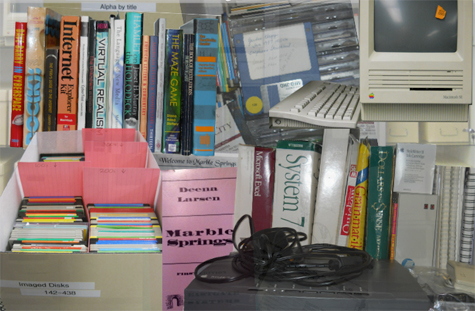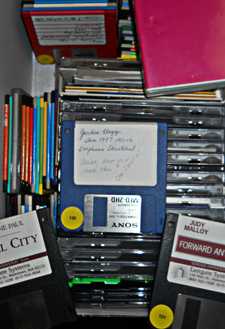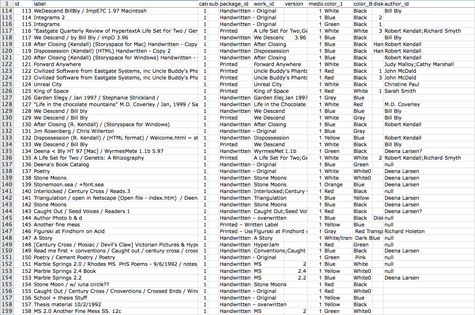“…it is a true hybrid collection. It is not just a collection of digital materials.” MITH Associate Director Matt Kirschenbaum
Before opening the display cases, you will be shown to the three-ring binder with The Deena Larsen Collection _Finding Aid, if you haven’t already accessed the electronic copy (scroll down to “The Collection Finding Aid” heading). The materials are inventoried in a spreadsheet of 18 tabs with categories such as “Authors,” “Manuals,” “Hardware,” “Articles,” “Correspondence,” and “Course Materials.” Many of the tabs relate to a specific archival box or set of boxes in the cases. There is also a separate finding aid spreadsheet for the 800+ (and growing) 3.5 inch floppy disk agglomeration that represent the most numerous single media item in the _Deena Larsen Collection (DLC).
The finding aids are vital to the researcher first coming to the DLC. Once you begin to crack open the boxes and binders on the shelves, you are confronted by the broad scope of the collection. The Deena Larsen Collection contains nearly 400 articles clipped from various sources, known and unknown, with another 150+ printed from various Web sources; materials from a dozen conferences; a hand-full of bound computer manuals from the days before everything was electronic PDF files; and the boxes of disks containing work from Larsen and many other e-literature authors, in various drafts and stages of completion.
Maryland Institute for Technology in the Humanities (MITH) Associate Director Matthew Kirschenbaum expects that most researchers will be drawn to the DLC for the array of e-literature to be found here. The disk boxes include hypertexts produced in HyperCard, StorySpace, and HTML. The authors represented include Stephanie Strickland, Judy Mallory, William Dickey, Bill Bly, and many others.
The collection also has disks with purchased and pirated copies of software. These may be useful as _DLC _researchers begin trying to access the files on the disks, if for instance, a dedicated work-station were loaded with the software of the era utilized by Larsen: HyperCard, MacWrite, MacPaint, Photoshop 4, etc.
As I noted in an earlier post, I was able to find a number of working versions of Marble Springs, Second Edition in the disk finding aid. However, some of these disks were not in the boxes. I searched through the boxes, and did not find them misfiled. Kirschenbaum told me that the MITH staff was able to successfully disk image about 70 percent of the 800+ disks cataloged. The remaining disks presented problems, either due to physical problems with the adding diskettes, or due to software incompatibility.
As I was working with the disk boxes, I thought that perhaps each box should have a box inventory sheet and an inventory control sheet, which would record instances of materials being checked out for research or preservation use. I have worked with such systems in other special collections, and have found it useful.
While each disk has been cataloged, the description is at the disk level, meaning that the description in the finding aid is based on the information on the label. The MITH staffers have yet had the time to do a file level description of the contents of each disk. This task is of course made more difficult by the fact that the Mac operating systems of the time did not always record the source program for files. So there is no telling if the “doc” files on a disk were created in MacWrite or Microsoft Word. (Although, when I queried Deena Larsen via email during my visit to MITH she told me they were likely MacWrite.)
And while each disk has been assigned an identifier, the same cannot be said for the articles and correspondence in the DLC. I think the Correspondence box could be improved with an ordered inventory and an identifier for each document. It may also be useful going forward to add a DLC identifying tag to materials, so it is clear where it came from. I am thinking here of the occasional document that gets left on the photocopier or scanner. A simple ID tag with the prefix “DLC” and the unique identifier would help the materials get returned to their proper home.
Cabinet and shelf numbering would also be helpful to future researchers. In my exuberance to look through the collection, I pulled out more than one box at a time, and found myself looking at the pictures I had taken to make sure I got things back in their proper places. (And that was after thesis advisor Jerry McDonough tweeted back to Kirschenbaum to make sure I tidied up after myself.)
The broad range of media types in this hybrid collection does present organizational challenges. The shower curtain, for instance, is too large to be stored in the display cases as they now exist. And the collection is growing. While I was there, I was allowed the chance to look through a box that Larsen had recently deposited. There are likely to be many more to come.
The DLC staff has a great start on collection organization, and with more use it can be made stronger for future researchers.
**Up next: **Accessing the DLC from a Distance
________________________________________________________________________
Want to schedule a visit to the DLC? Use the form at http://mith.umd.edu/larsen/contact
Citations:
Quotations from MITH Associate Director Matthew Kirschenbaum are from an interview with the author conducted April 15, 2011, at MITH, unless otherwise noted.
Image credits:
The_Deena_Larsen_Collage.png, Leighton Christiansen, April 14, 2011
DLC_discs_01.png, Leighton Christiansen, April 14, 2011
DLC_disk_find_sample.png, Leighton Christiansen, May 16, 2011
Leighton Christiansen is pursing his Master’s of Library and Information Science Degree at the Graduate School of Library and Information Science (GSLIS), at the University of Illinois at Urbana-Champaign, and threatens to catch that degree any time now.
You can reach him at leightonlc@gmail.com, or @purpleleighton on Twitter



